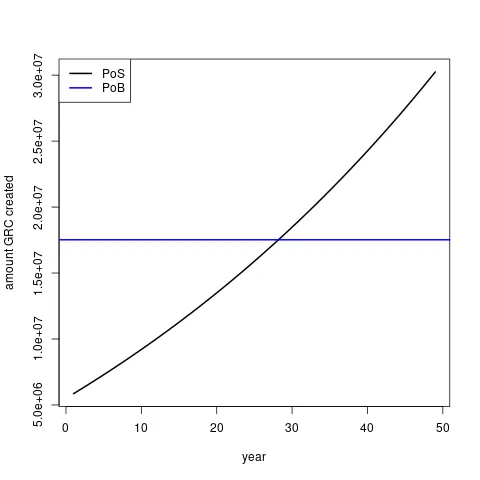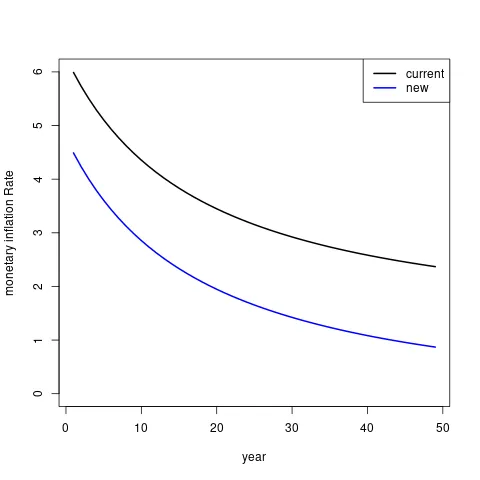I am not going to introduce Gridcoin. So if you don't know what it is, this article is probably not for you and you should visit https://gridcoin.us/ to inform yourself.
Currently Gridcoin rewards its users in two ways. The first one is inherited from the pure PoS system Gridcoin is build upon. Every user who is staking a block is rewarded for it by generating a certain amount of new gridcoins. This amount is determined in a way that the yearly monetary inflation of the coins used for staking is approximately 1.5%.
The second way of earning rewards is through the contribution of computational resources to specific BOINC projects (PoB). This mechanism creates approximately 48000 GRC each day. That corresponds to a block reward of 50 GRC on average.
Implications for the Gridcoin network
For the following calculations it is assumed that every coin ever created is staking wich is obviously not true. But there is no reliable mechanism to figure out how many coins are used for staking. It is also not taken into account that there is compound interest throughout the year.
The current coin supply is 390,287,782 GRC and one can easily calculate the current yearly monetary inflation:
approx. monetary inflation through PoS: 0.015 x coin supply = 5,854,316.73 GRC
yearly paid PoB reward: 365 x 48000 GRC = 17,520,000 GRC
That leads approximately to a total monetary inflation rate of:
(5,854,316.73 GRC + 17,520,000 GRC)/390,287,782 GRC x 100 = 5.98%
So that looks all good, right? The amount of GRC generated via PoB is much higher than the coins created via PoS to ensure there is incentive to contribute to scientific computations. There is also an interest rate of 1.5% as an incentive for inverstors.
Ok then, lets take a look. My first claim that more GRC are generated by people contributing to scientific calculations might not be true.

In the plot you can see the amount of GRC being created each year over the next 50 years by PoS and PoB.
As you can see the amount of coins being created via PoB is constant while the amount of coins being created via PoS is increasing. In about 30 years potentially more coins are created by PoS instead of PoB. Ok, to be fair 30 years is a long time but if Gridcoin wants to be succesful it should work as intended for any amount of time.
Then what about the incentive to invest in Gridcoin? Right now the yearly monetary inflation rate lies somewhere between 4.48% (only taking PoB into account) and 5.98%. With a yearly interest rate of 1.5% your share of the total money supply will still decrease. So from an investor point of view the most important thing is an increasing userbase and market interest in the coin.
How to make things better?
First of all Gridcoin needs inflation. If there was a fixed coin supply like bitcoin offers it would be very difficult to keep up the incentive to do BOINC computations. But maybe the inflation can be lower and tending towards 0% instead of 1.5%. That could be achieved with a fixed block reward. Instead of getting a yearly reward of 1.5% for staking you would get a fixed amount of GRC for each block you stake. That would also increase the incentive to stake all the time instead of collecting your rewards only once in a while. And it would solve the problem with the amount of GRC being created by PoS vs PoB.
Additionally Gridcoin could adopt something like the budget system in DASH and some other cryptocurrencies. The idea is that a fraction of the block reward is not given to the account that staked the block but is credited to an address that is owned by the network itself. These funds could then be used to finance further development and promotion of gridcoin, very much like the foundation funds gridcoin already has left over from the transition to Gridcoin Research. It would generate a constant income to secure the funding of future projects.
Additionally part of these funds could be used to support science. Each whitelisted project could be rewarded with gridcoins. The project leaders could then decide what they want to do with these funds. (rain over the participants, reduce server costs, buy new hardware etc.)
How could a new reward system actually look like?
Lets set the average total block reward to 50 GRC (or 48000 GRC per day). It is the same number of gridcoins currently being generated by PoB only. So with that the current monetary inflation rate would drop to 4.48% and would slowly decrease.
The following table shows a possible distribution of the total rewards over PoS, PoB and the foundation budget.
| / | PoS reward | PoB reward | decentralized foundation budget | total |
|---|---|---|---|---|
| share | 20% | 60% | 20% | 100% |
| average block reward | 10 GRC | 30 GRC | 10 GRC | 50 GRC |
| yearly rewards | 3,504,000 GRC | 10,512,000 GRC | 3,504,000 GRC | 17,520,000 GRC |
In the following plot you can see the approximated inflation rate over the next 50 years for the current reward system and the proposed new reward system.

As you can see the monetary inflation would be lower than it is with the current reward system. It would tend towards 0% but never actually reach it. In 20 years the monetary inflation would still be at 2% per year. And that is not taking lost coins or burned coins into account.
Conclusion
With a new reward system Gridcoin could not only secure funding for future development and projects, it could also help scientific projects with rewards/donations through the decentralized foundation. Helping and funding BOINC projects is in the own interest of Gridcoin. With great BOINC projects the interest in Gridcoin will also increase. This will hopefully lead to a self-sustaining decentralised network. Investors and BOINC contributors will profit from this. And last but not least investors will recognize the lower monetary inflation.